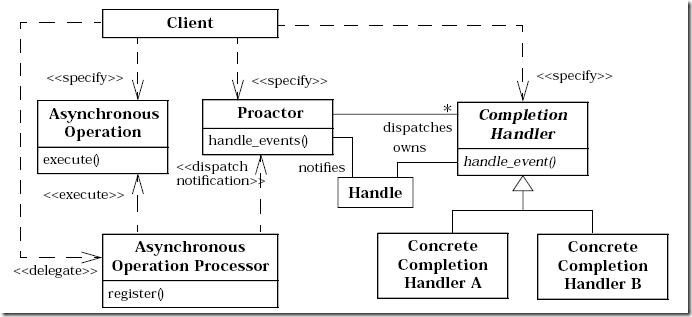6.6.2008
Kevin Lynx
Proactor和Reactor都是并發編程中的設計模式。在我看來,他們都是用于派發/分離IO操作事件的。這里所謂的
IO事件也就是諸如read/write的IO操作。"派發/分離"就是將單獨的IO事件通知到上層模塊。兩個模式不同的地方
在于,Proactor用于異步IO,而Reactor用于同步IO。
摘抄一些關鍵的東西:
"
Two patterns that involve event demultiplexors are called Reactor and Proactor [1]. The Reactor patterns
involve synchronous I/O, whereas the Proactor pattern involves asynchronous I/O.
"
關于兩個模式的大致模型,從以下文字基本可以明白:
"
An example will help you understand the difference between Reactor and Proactor. We will focus on the read
operation here, as the write implementation is similar. Here's a read in Reactor:
* An event handler declares interest in I/O events that indicate readiness for read on a particular socket ;
* The event demultiplexor waits for events ;
* An event comes in and wakes-up the demultiplexor, and the demultiplexor calls the appropriate handler;
* The event handler performs the actual read operation, handles the data read, declares renewed interest in
I/O events, and returns control to the dispatcher .
By comparison, here is a read operation in Proactor (true async):
* A handler initiates an asynchronous read operation (note: the OS must support asynchronous I/O). In this
case, the handler does not care about I/O readiness events, but is instead registers interest in receiving
completion events;
* The event demultiplexor waits until the operation is completed ;
* While the event demultiplexor waits, the OS executes the read operation in a parallel kernel thread, puts
data into a user-defined buffer, and notifies the event demultiplexor that the read is complete ;
* The event demultiplexor calls the appropriate handler;
* The event handler handles the data from user defined buffer, starts a new asynchronous operation, and returns
control to the event demultiplexor.
"
可以看出,兩個模式的相同點,都是對某個IO事件的事件通知(即告訴某個模塊,這個IO操作可以進行或已經完成)。在結構
上,兩者也有相同點:demultiplexor負責提交IO操作(異步)、查詢設備是否可操作(同步),然后當條件滿足時,就回調handler。
不同點在于,異步情況下(Proactor),當回調handler時,表示IO操作已經完成;同步情況下(Reactor),回調handler時,表示
IO設備可以進行某個操作(can read or can write),handler這個時候開始提交操作。
用select模型寫個簡單的reactor,大致為:

 /**////
/**//// class handler
class handler


 {
{
 public:
public:
 virtual void onRead() = 0;
virtual void onRead() = 0;
 virtual void onWrite() = 0;
virtual void onWrite() = 0;
 virtual void onAccept() = 0;
virtual void onAccept() = 0;
 };
};

 class dispatch
class dispatch


 {
{
 public:
public:
 void poll()
void poll()


 {
{
 // add fd in the set.
// add fd in the set.
 //
//
 // poll every fd
// poll every fd
 int c = select( 0, &read_fd, &write_fd, 0, 0 );
int c = select( 0, &read_fd, &write_fd, 0, 0 );
 if( c > 0 )
if( c > 0 )


 {
{
 for each fd in the read_fd_set
for each fd in the read_fd_set


 { if fd can read
{ if fd can read
 _handler->onRead();
_handler->onRead();
 if fd can accept
if fd can accept
 _handler->onAccept();
_handler->onAccept();
 }
}

 for each fd in the write_fd_set
for each fd in the write_fd_set


 {
{
 if fd can write
if fd can write
 _handler->onWrite();
_handler->onWrite();
 }
}
 }
}
 }
}

 void setHandler( handler *_h )
void setHandler( handler *_h )


 {
{
 _handler = _h;
_handler = _h;
 }
}

 private:
private:
 handler *_handler;
handler *_handler;
 };
};


 /**//// application
/**//// application class MyHandler : public handler
class MyHandler : public handler


 {
{
 public:
public:
 void onRead()
void onRead()


 {
{
 }
}

 void onWrite()
void onWrite()


 {
{
 }
}

 void onAccept()
void onAccept()


 {
{
 }
}
 };
};


在網上找了份Proactor模式比較正式的文檔,其給出了一個總體的UML類圖,比較全面:

根據這份圖我隨便寫了個例子代碼:
 class AsyIOProcessor
class AsyIOProcessor


 {
{
 public:
public:
 void do_read()
void do_read()


 {
{
 //
// send read operation to OS
send read operation to OS
 // read io finished.and dispatch notification
// read io finished.and dispatch notification
 _proactor->dispatch_read();
_proactor->dispatch_read();
 }
}

 private:
private:
 Proactor *_proactor;
Proactor *_proactor;
 };
};

 class Proactor
class Proactor


 {
{
 public:
public:
 void dispatch_read()
void dispatch_read()


 {
{
 _handlerMgr->onRead();
_handlerMgr->onRead();
 }
}

 private:
private:
 HandlerManager *_handlerMgr;
HandlerManager *_handlerMgr;
 };
};

 class HandlerManager
class HandlerManager


 {
{
 public:
public:
 typedef std::list<Handler*> HandlerList;
typedef std::list<Handler*> HandlerList;

 public:
public:
 void onRead()
void onRead()


 {
{
 // notify all the handlers.
// notify all the handlers.
 std::for_each( _handlers.begin(), _handlers.end(), onRead );
std::for_each( _handlers.begin(), _handlers.end(), onRead );
 }
}

 private:
private:
 HandlerList *_handlers;
HandlerList *_handlers;
 };
};

 class Handler
class Handler


 {
{
 public:
public:
 virtual void onRead() = 0;
virtual void onRead() = 0;
 };
};

 // application level handler.
// application level handler.
 class MyHandler : public Handler
class MyHandler : public Handler


 {
{
 public:
public:
 void onRead()
void onRead()


 {
{
 //
//
 }
}
 };
};


Reactor通過某種變形,可以將其改裝為Proactor,在某些不支持異步IO的系統上,也可以隱藏底層的實現,利于編寫跨平臺
代碼。我們只需要在dispatch(也就是demultiplexor)中封裝同步IO操作的代碼,在上層,用戶提交自己的緩沖區到這一層,
這一層檢查到設備可操作時,不像原來立即回調handler,而是開始IO操作,然后將操作結果放到用戶緩沖區(讀),然后再
回調handler。這樣,對于上層handler而言,就像是proactor一樣。詳細技法參見這篇文章。
其實就設計模式而言,我個人覺得某個模式其實是沒有完全固定的結構的。不能說某個模式里就肯定會有某個類,類之間的
關系就肯定是這樣。在實際寫程序過程中也很少去特別地實現某個模式,只能說模式會給你更多更好的架構方案。
最近在看spserver的代碼,看到別人提各種并發系統中的模式,有點眼紅,于是才來掃掃盲。知道什么是leader follower模式,
reactor, proactor,multiplexing,對于心中的那個網絡庫也越來越清晰。
最近還干了些離譜的事,寫了傳說中的字節流編碼,用模板的方式實現,不但保持了擴展性,還少寫很多代碼;處于效率考慮,
寫了個static array容器(其實就是template <typename _Tp, std::size_t size> class static_array { _Tp _con[size]),
加了iterator,遵循STL標準,可以結合進STL的各個generic algorithm用,自我感覺不錯。基礎模塊搭建完畢,解析了公司
服務器網絡模塊的消息,我是不是真的打算用自己的網絡模塊重寫我的驗證服務器?在另一個給公司寫的工具里,因為實在厭惡
越來越多的重復代碼,索性寫了幾個宏,還真的做到了代碼的自動生成:D。
對優雅代碼的追求真的成了種癖好. = =|